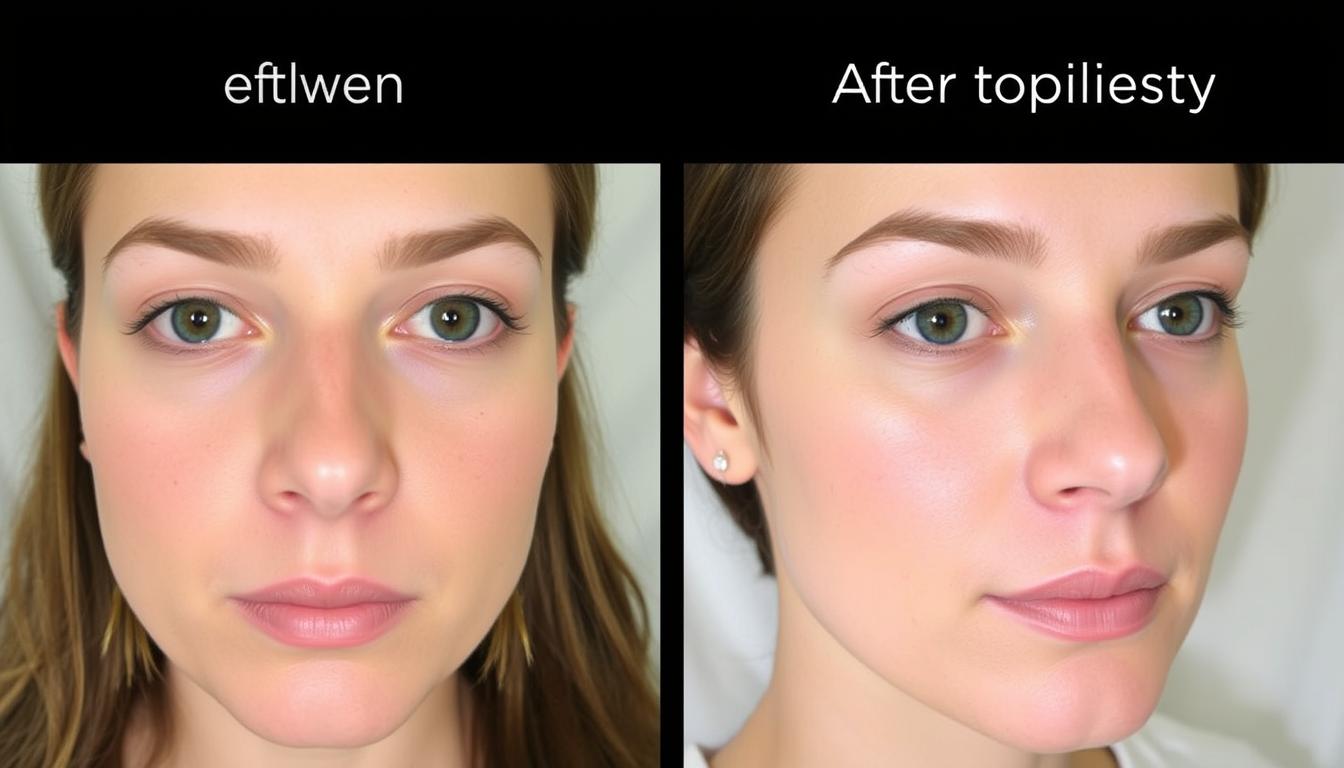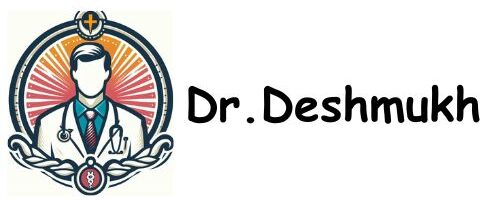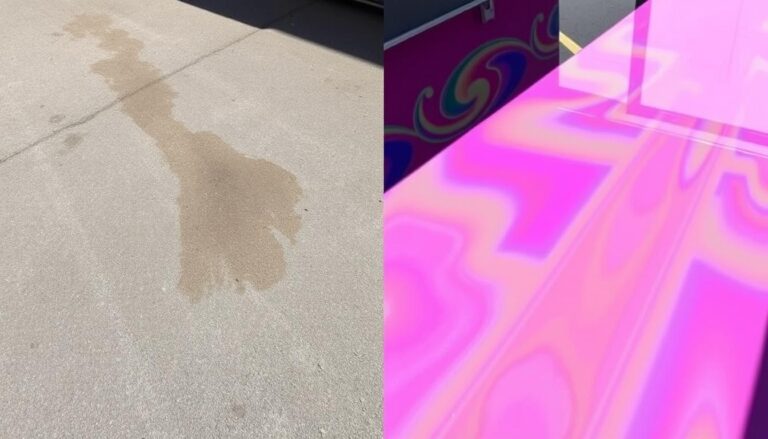Septoplasty Before and After: Visual Results Guide

Did you know septoplasty, a surgery for a deviated nasal septum, works for up to 85% of people? This shows how important this surgery is. It can make a big difference in how you look and breathe.
In this guide, we’ll show you what septoplasty can do before and after. We’ll use real patient pictures to show the surgery’s effects. This way, you can see how it can change someone’s life for the better.
Looking at the septoplasty results, you might see how it can improve your life too. It’s all about better breathing and looking good.
Table of Contents
What is Septoplasty?
Septoplasty is a surgery to fix a deviated septum. This is the wall between the nostrils made of cartilage and bone. The main goal is to improve breathing by fixing the nasal passages.
Many people have trouble breathing because of a deviated septum. This can lead to sinus infections and other problems. Fixing the septum can greatly improve their quality of life.
Definition and Purpose
Septoplasty is a key part of nasal surgery for those with breathing issues. The surgeon reshapes or moves the septum’s cartilage and bone. This makes breathing easier and helps with sinus infections, snoring, and sleep apnea.
This surgery is often done as an outpatient procedure. This means patients can go home the same day. It’s a minimally invasive way to fix breathing problems.
Understanding the Nasal Septum
The nasal septum is crucial for breathing. When it’s off, breathing can be tough. There are different types of septoplasty, like open septoplasty and endoscopic techniques.
Doctors choose the best method based on the problem. For example, spurectomy fixes blockages in the nasal passage. Septoplasty can bring lasting relief from breathing troubles.
Who Needs Septoplasty?
Septoplasty is often recommended for those with a deviated septum. This condition can cause many symptoms that affect daily life. Knowing the symptoms of a deviated septum helps figure out when surgery is needed.
Symptoms of a Deviated Septum
Common nasal obstruction signs include:
- Nasal congestion or blockage
- Frequent sinus infections
- Difficulty breathing through the nose
- Headaches
- Snoring or sleep apnea
These symptoms can hurt sleep and overall quality of life. If someone shows these signs often, they might need a detailed check-up.
Diagnosing the Condition
To diagnose a deviated septum, doctors do a thorough check. This includes:
- Physical examination of the nasal passages
- Nasal endoscopy to see the septum up close
- Imaging studies like CT scans for more details
Doctors find these steps key to figuring out how bad the deviation is. Knowing about these steps helps people get the right treatment. This can improve their nasal function and life quality. For more on health issues, see this resource.
The Septoplasty Procedure
The septoplasty procedure is a key surgery to fix the nasal septum. It’s important to know about this nasal surgery process if you’re thinking about it. It can greatly improve your health and mood. Most people go home the same day after the surgery.
Overview of the Surgery
A surgeon makes a small cut inside the nose for the septoplasty. This way, they can fix the septum without leaving scars outside. They then reshape the septum and move the mucosa to help it heal.
This careful method keeps the rest of the nose safe and helps you heal faster. Many people say they breathe better and feel less stuffy after the surgery. This can make you feel more alive and able to do more things.
Anesthesia and Duration
Most people have septoplasty under general anesthesia. But, local anesthesia in septoplasty might be used in some cases. The surgery usually takes 30 to 90 minutes, depending on how complex it is.
This time lets the surgeon do a detailed job. It also makes sure you’re comfortable and safe during the surgery.
Pre-Treatment Care for Septoplasty
Getting ready for septoplasty means taking a few key steps to help your recovery. Before surgery, it’s crucial to follow your doctor’s advice closely. They will give you pre-operative care for septoplasty to lower risks and aid in healing.
Preparing for Surgery
First, arrange for someone to help you after surgery. This person should drive you home and assist for at least 24 hours. You’ll need to fast for about eight hours before the surgery and avoid eating or drinking after midnight. Quitting smoking two weeks before can also help your healing.
Keeping your head up and drinking plenty of water can help with pain. These steps are important for a smooth recovery.
Medications to Avoid
It’s important to know which medications to avoid before surgery. Your doctor will tell you to stop taking aspirin and NSAIDs for a week. These can make it harder for blood to clot. Also, stop taking herbal medicines and supplements to avoid problems.
Acetaminophen is a safe choice for pain relief. It doesn’t raise the risk of bleeding like other options do.
| Action | Details |
|---|---|
| Arrange Transportation | Have someone drive you home and assist for at least 24 hours. |
| Fasting | No food or beverages after midnight prior to surgery. |
| Smoking | Quit at least two weeks before the procedure. |
| Medication Guidelines | Avoid aspirin and NSAIDs for a week prior; consider acetaminophen for pain relief. |
| Hydration | Stay well-hydrated before and after surgery. |
Before and After Treatment Pictures
Septoplasty’s success is shown through real patient changes. These pictures highlight improvements in looks and function. They show how nasal surgery can change a person’s breathing and structure.
Real Patient Transformations
Many patients have seen big changes after septoplasty. Those with breathing problems or uneven noses have noticed big improvements.
- Enhanced nasal symmetry and airway support
- Reduction in chronic congestion and discomfort
- Improved facial aesthetics contributing to overall confidence
Visual Progression
Photos show the recovery journey after nasal surgery. They show how swelling and bruises go down. Recovery can take weeks to months, with gradual improvements.
These pictures show how patients breathe better after septoplasty. This leads to more energy, better sleep, and fewer headaches and sinus infections.
Post-Treatment Care for Septoplasty
After septoplasty, it’s key to follow post-operative care for a smooth recovery. You might feel discomfort and swelling. Knowing how to handle these symptoms helps a lot. Always talk to your healthcare provider for the best recovery tips.
Managing Discomfort and Swelling
Managing pain after surgery is important. You’ll get pain meds and learn home care tips. Here are some steps to take:
- Apply ice or cold packs to the nose for 10 to 20 minutes at a time to reduce swelling.
- Keep the head elevated while resting by using two pillows to help minimize swelling.
- Use saline nasal washes regularly to maintain open nasal passages and remove mucus.
- Avoid bending over or lifting heavy objects (over 10 pounds) for at least one week.
- Refrain from blowing your nose for one week, as this can hinder healing.
You might feel numb in areas like the nose tip or upper lip. This usually goes away in weeks to months. Following these tips helps your recovery.
Follow-Up Appointments
Regular check-ups are important to track your recovery. You’ll likely see your doctor 3 to 4 months after surgery. This is to make sure you’re healing right. Any worries or odd symptoms should be talked about at these visits.
It’s crucial to follow your surgeon’s care instructions. This includes wound care and what activities to avoid. This helps prevent problems and complications.
| Activity | Timeline | Notes |
|---|---|---|
| Resume light activities | 1 week | Avoid strenuous activities for a month. |
| Return to work or school | 3-5 days | Consult with your doctor regarding considerations. |
| Full recovery | 1-3 months | Especially if additional nasal procedures were conducted. |
Risks and Complications of Septoplasty
It’s key to know the septoplasty risks before getting this surgery. Many people do well after the procedure. But, it’s smart to understand the possible problems that can happen. Knowing these risks helps make your recovery safer and tells you when to seek help if you have unusual symptoms after surgery.
Common Risks to Consider
Septoplasty complications are rare but can occur. Here are the most common risks:
- Excessive Bleeding: This happens in about 3.3% of cases
- Septal Perforation: Seen in roughly 2.3% of patients
- Infection: This is reported in 3.1% of cases, causing longer healing times
- Hyposmia: A 3.1% chance of a reduced sense of smell, often linked to turbinate reduction
- Adhesions: Rare, found in only 0.3% of instances
- Ocular Complications: Temporary vision issues in 0.08% of cases
- Nerve Injury: Numbness around the tooth or upper lip in 0.1% of patients
When to Contact Your Doctor
Knowing when to seek help after septoplasty is vital for a smooth recovery. You should get immediate medical help if you notice:
- Severe bleeding that won’t stop
- Signs of infection, like fever or increased pain
- Worsening changes in your sense of smell or taste
- Persistent pain that doesn’t get better with medicine
- Swelling or bruising around the eyes
- Any vision changes
Talking to your doctor right away for any concerning symptoms is important. It helps avoid serious problems. Keeping in touch with your healthcare team is key to a good recovery.
| Complications | Incidence Rate |
|---|---|
| Excessive Bleeding | 3.3% |
| Septal Perforation | 2.3% |
| Hyposmia | 3.1% |
| Infection | 3.1% |
| Adhesions | 0.3% |
| Nerve Injury | 0.1% |
| Ocular Complications | 0.08% |
Recommended Products for Pre and Post Treatment
Proper nasal care after surgery is key to a smooth recovery. The right products help keep your nose clean and comfortable. Here are some must-haves for your healing journey.
Nasal Sprays and Humidifiers
Saline nasal sprays keep your nose moist and clean. They reduce discomfort and prevent crusting. A humidifier also helps by adding moisture to the air. This makes breathing easier, especially in dry environments.
Pain Relief Options
Pain after surgery can last for weeks. Having good pain relief options makes recovery easier. Over-the-counter Tylenol Extra Strength is a top choice, priced at $9.47 for 100 caplets.
For more severe pain, doctors may prescribe stronger meds. Ice packs, at $12.99 for five, can also help by reducing swelling.
| Product | Price Range | Usage |
|---|---|---|
| Saline Nasal Spray | $3.97 – $10.00 | Maintain moisture in nasal passages |
| Humidifier | $20.00 – $42.97 | Enhance air moisture to improve breathing |
| Tylenol Extra Strength | $9.47 | Pain relief |
| Mini Ice Packs (5-pack) | $12.99 | Reduce swelling |
| Gel Eye Mask | $7.97 | Soothing relief for surrounding areas |
| Arnica Gel | $7.83 – $10.06 | Bruise treatment |
| Lightweight Hoodie | $9.17 and up | Comforting clothing during recovery |
Having the right products for septoplasty makes recovery easier. Make sure you have these items ready. It helps you focus on healing and taking care of your nose.
Alternative Treatments for Nasal Obstructions
Nasal obstructions can really affect your life. People look for ways to feel better. Options like nasal dilators and strips, and non-surgical methods, offer quick relief. They help improve airflow without surgery.
Nasal Dilators and Strips
Nasal dilators and strips are popular for quick relief from nasal congestion. They work by opening up the nostrils, making it easier to breathe. They are easy to use and are a good choice for many people.
Non-Surgical Approaches
There are many non-surgical ways to help with nasal obstructions. Nasal corticosteroid sprays can help, but it may take a few weeks to see the full effect. Antihistamines help with allergies, and decongestants reduce swelling in the nose. These methods aim to make breathing easier without surgery.
| Treatment Type | How It Works | Effectiveness Timeline |
|---|---|---|
| Nasal Dilators and Strips | Widen nostrils to improve airflow | Immediate relief |
| Nasal Corticosteroid Sprays | Reduce inflammation in nasal passages | 1 to 3 weeks for maximum effect |
| Antihistamines | Block allergy symptoms | Variable, depending on individual response |
| Decongestants | Reduce nasal tissue swelling | Immediate to short-term relief |
Cost of Septoplasty in the United States
The cost of septoplasty is a big factor in deciding to get the surgery. Knowing the cost and what insurance covers is key. Prices vary due to location, surgeon’s skill, and how complex the surgery is.
Average Expense Overview
The cost of septoplasty in the U.S. can range a lot. For example, in New York City, it’s between $4,000 and $10,000. Several things affect this price:
- The surgeon’s expertise and reputation
- The surgery’s complexity
- Anesthesia fees
- Facility fees
- Pre- and post-operative care
More experienced surgeons might charge more. Also, living in a big city can make healthcare more expensive.
Insurance Coverage Options
Most insurance plans cover septoplasty if it’s needed for health reasons. This includes chronic nasal blockage or sinus infections. It’s important to check your insurance before surgery to know what you’ll pay out of pocket. Without insurance, the cost can be between $5,000 and $10,000.
Talking to a specialist can help you understand your options. They can give you a septoplasty pricing USA estimate that fits your situation. Also, many people see big improvements after surgery, with over 90% reporting good results.
For more advice, look into orthopedic footwear for health and comfort. More info is available here.
Finding Septoplasty Treatment Near You
Finding a good surgeon for septoplasty is key for the best results. You need to look at their credentials, experience, and what past patients say. Doing your homework can really make a difference in your care.
How to Choose a Qualified Surgeon
Choosing the right ENT for septoplasty takes a few steps:
- Ask for recommendations from your doctor or other patients.
- Check if the surgeon is certified by professional groups.
- See how much experience they have with septoplasty.
- Look at their hospital affiliations.
By focusing on these points, you can find a surgeon who fits your health needs.
Checking Credentials and Reviews
Looking at surgeon reviews is crucial. Search for:
- What past patients say about their results.
- How well the surgeon communicates and treats patients.
- How happy patients are with their recovery.
Also, check out this guide on finding a therapist. It shows how important it is to find the right professional. Finding the right septoplasty surgeon can make a big difference in your outcome.
Septoplasty Recovery Timeline
Knowing the septoplasty recovery timeline is key for those thinking about nasal surgery. This part gives a week-by-week look at healing after surgery. It shows what to expect as you get back to your normal life. Every person’s healing is different, but this guide gives a general idea of what to expect and important milestones.
What to Expect Each Week
Recovery goes through different stages in the first few weeks after surgery:
| Week | Recovery Milestones | Notes |
|---|---|---|
| 1 | Rest at home; manage pain with medications. | Swelling and bruising noticeable; nasal splints in place. |
| 2-3 | Reduction in swelling; possible return to light activities. | May still need to avoid strenuous tasks. |
| 4-6 | Notable healing; internal splints removed. | Minor stiffness may persist; monitor for any unusual symptoms. |
| Beyond 6 | Continued improvement in nasal function. | Full benefit may take a few months to realize. |
Returning to Normal Activities
Most people can start getting back to their daily life in 7 to 14 days. Eating and drinking normally usually happens quickly. This lets people do light activities.
It’s crucial to stay hydrated and avoid hard work, like sports or heavy lifting, early on. Don’t blow your nose or use nasal sprays at first to avoid problems. Watching for signs of healing helps you smoothly get back to your usual life.
Long-Term Benefits of Septoplasty
Septoplasty brings big changes to how well you breathe and feel. It fixes problems like blocked noses and makes breathing easier. People often say they feel better and breathe better after the surgery.
Improved Breathing and Quality of Life
Septoplasty does more than just fix your nose. It makes breathing better right away. Studies show people feel more comfortable and breathe easier after surgery.
Feeling better physically and emotionally makes life more enjoyable. People notice they can breathe better, which makes life easier.
Possible Changes to Sleep Patterns
Septoplasty can also help you sleep better. With better breathing, snoring and sleep apnea often get better. This means you can sleep more soundly and wake up feeling good.
Along with good sleep habits, septoplasty can make sleeping even better. Check out this resource for tips on better sleep.
| Time Frame | NOSE Score (Mean ± SD) | Quality of Life Improvement |
|---|---|---|
| Preoperative | 58.4 ± 23.7 | Base level of breathing difficulties |
| 3 Months Postoperative | 15.0 ± 18.6 | Significant improvement in nasal function |
| 6 Months Postoperative | Higher than 3 Months | Continued enhancement in quality of life |
| 36 Months Postoperative | Statistically significant with mild symptoms | Sustained nasal function improvements |
In summary, septoplasty makes breathing and feeling better last a long time. It shows how important healthy nasal passages are. Surgery can really change lives for the better.
Living with a Healthy Nasal Structure
After septoplasty, keeping your nose healthy is key for lasting results. Focus on a few important habits to help your nose heal and improve your life.
Maintaining Results Over Time
Healthy habits are vital for a long-lasting, working nose. Regular doctor visits are important to check on your nose’s health. Drinking lots of water helps your nose’s lining work well.
Using humidifiers keeps your nose moist and comfy. Managing allergies with meds or lifestyle changes also helps keep your nose healthy.
Routine Care for Your Nasal Health
Adding nasal irrigation to your daily routine can remove allergens and debris. Avoid hard activities that might hurt your nose when you’re first recovering. Saline sprays can add moisture to your nose’s membranes.
| Routine Care Practices | Description |
|---|---|
| Stay Hydrated | Drinking plenty of water helps maintain optimal mucus function in the nasal passages. |
| Nasal Irrigation | Using saline solutions helps clear out allergens and keeps the nasal passages clean. |
| Humidifier Use | Maintaining humidity in living spaces prevents dryness and irritation of the nasal passages. |
| Allergy Management | Controlling environmental allergens can significantly reduce nasal obstruction. |
| Follow-Up Appointments | Regular check-ups help assess and monitor your nasal health over time. |
By following these steps, you can take good care of your nose for the long term. This helps you recover smoothly and enjoy a better life after septoplasty.
Conclusion
Septoplasty is a life-changing surgery that boosts both breathing and looks. It helps 75% of people breathe better and 25% look better. This surgery can make a big difference for those who can’t breathe well or are unhappy with their nose.
Many people, like Allison, see big improvements after the surgery. They breathe better, sleep better, and feel more confident. This surgery can really improve how you feel and look.
It’s important to talk to a doctor before getting septoplasty. They can help you decide if it’s right for you. This way, you can make a choice that fits your health and beauty goals.
FAQ
What is septoplasty?
What are the common symptoms of a deviated septum?
How long does the septoplasty procedure take?
What should I do to prepare for septoplasty?
Are there visible changes after septoplasty?
How does the recovery process work after septoplasty?
What are the risks associated with septoplasty?
What products can help with recovery after septoplasty?
What alternative treatments are available for nasal obstructions?
How much does septoplasty typically cost?
How can I find a qualified surgeon for septoplasty?
What long-term benefits can I expect from septoplasty?
How can I maintain my nasal health after surgery?







